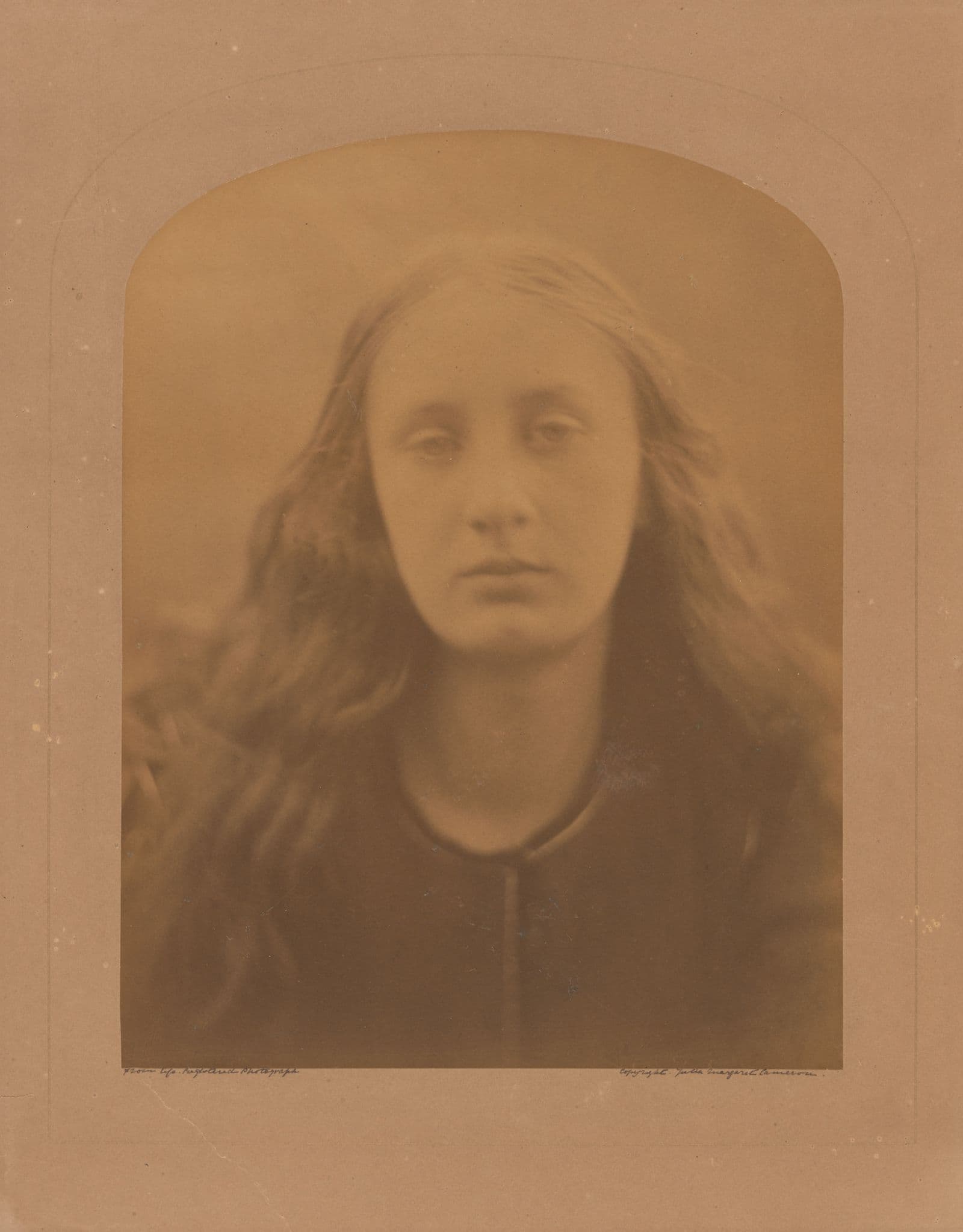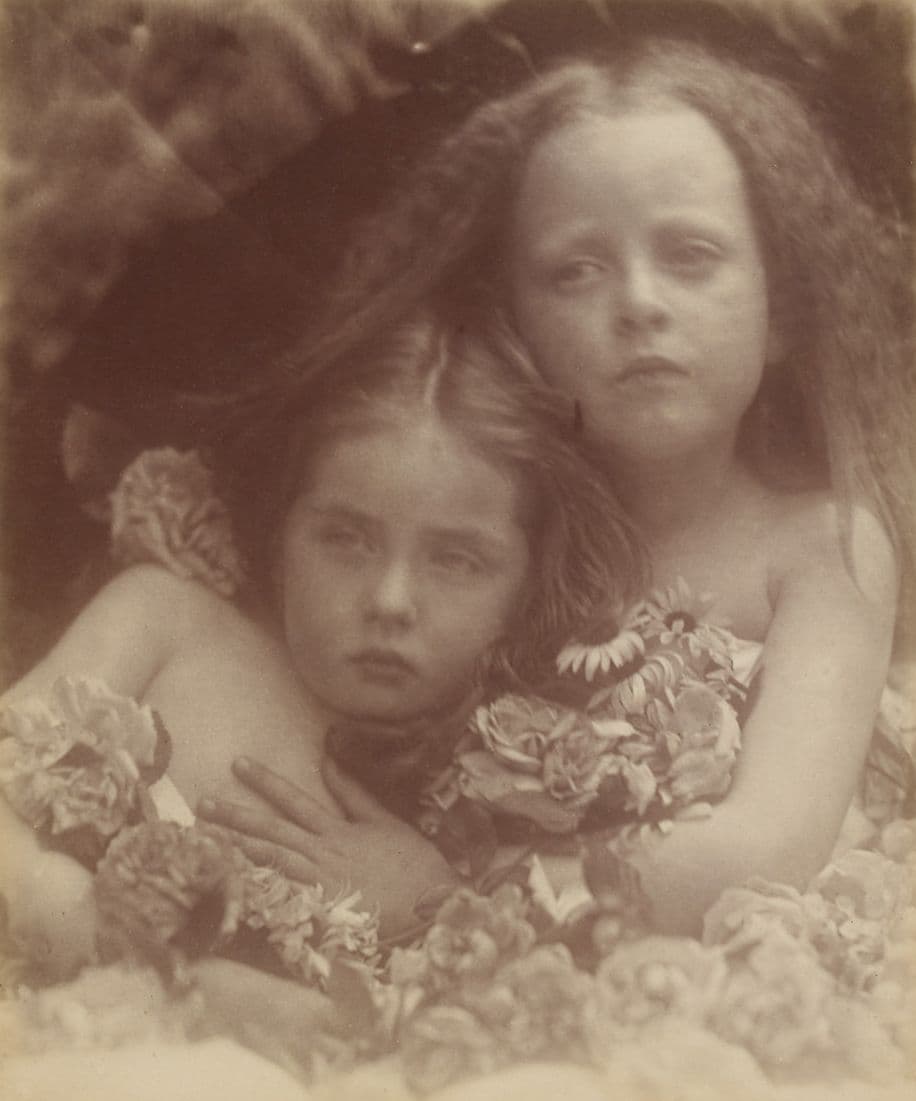Julia Margaret Cameron’s Christabel 1866

SHAUNE LAKIN and ANNE O’HEHIR explore the provenance of the National Gallery’s print of one of Julia Margaret Cameron’s most famous photographs.
In September 1978, the National Gallery acquired a well-travelled print of Julia Margaret Cameron’s photograph Christabel 1866. It was the first photograph by the pioneering British photographer to enter the national collection, where it was joined the following year by another five of her famous photographs illustrating figures drawn from British literature and fable.
Cameron was one of the great photographers of the Victorian age. Her style is highly distinctive and recognisable, and she has been rightly subjected to substantial critical interest because of her stylistic innovations. As well as being a fine example of Cameron’s endeavour to bring together art and photography soon after photography’s invention, the print of Christabel brought with it a curious provenance. Most nineteenth-century photographs have become unmoored from their histories of ownership, the identities of the people whose hands held them now lost. But the story of Christabel’s ownership is virtually complete, and shows how people, families and communities can be connected through photography. It is a story that illuminates connections between families serving Empire at home in Britain, in colonial India and Australia – one that shows how photographs themselves were bearers of imperial ambition and style.
Christabel depicts Cameron’s niece Mary ‘May’ Prinsep as the protagonist of Samuel Taylor Coleridge’s account of teenage desire, his poem ‘Christabel’ (1816). The poem tells the story of the pure and virtuous Christabel who, while praying in the woods one night, meets a mysterious, distressed stranger, Geraldine, who she takes home. Geraldine, who is in fact an evil spirit, seduces both Christabel and her father before ultimately driving a wedge between father and daughter. With its Gothic preoccupation with female sexuality, lost innocence and supernatural malevolence, ‘Christobel’ was immensely popular with British artists and a subject that the always-entrepreneurial Cameron used as the basis of a portrait she described as ‘my spiritual and glorious head’.1 Christabel quickly became one of her most famous photographs.

Julia Margaret Cameron, English flowers. 1873, National Gallery of Australia, Kamberri/Canberra, purchased 1979
The photograph was taken with a 10 x 12 inch glass-plate camera given to Cameron in late 1863 that allowed her to make large portraits. Due to Cameron’s often loose approach to handling the delicate chemicals and the technical aspects of photography at this time, the collodion emulsion on the negative used for ‘Christabel’ had cracked and blistered. But as was often the case with Cameron’s highly experimental approach to the medium, she took advantage of these accidents and imperfections, which when printed added to the otherworldly character of the portrait. She made at least 17 prints of ‘Christabel’, with albumen and carbon prints held in the collections of the Metropolitan Museum in New York, the Musée d’Orsay, Paris, the Victoria & Albert Museum in London, and the National Gallery of Australia.
While still beautiful, the National Gallery’s albumen print has faded since it was printed and signed in 1866 by Cameron at her home in Freshwater on the Isle of Wight. The submission for its acquisition by the gallery in September 1978 noted that it had ‘faded to a uniform brown’, a process of chemical degradation that has since then been held in stasis in the gallery’s dark, climate-controlled storage. This was no doubt in part because it had been proudly on display in the home of its previous owners, Charles and Effie Bean, on Guringai Nura/Sydney’s northern beaches. Charles Bean (1879‒1968) was one of Australia’s most distinguished journalists and historians; Australia’s official war correspondent during the First World War, his did much to build the myth of the Anzac and was one of the founders of the Australian War Memorial. A decade after his death, Bean’s widow Effie sold the family’s print of Christabel to the National Gallery. The photograph clearly held great significance for Bean and for the Bean family. The family shared a range of connections to the print and its provenance, to its subject and to the artist who made it, connections which reveal much about how Cameron’s work circulated globally during the late nineteenth and early twentieth centuries. This is an example of a work of art whose significance rests as much, if not more, in its provenance as it does in its current condition, and where the story of its ownership can be seen to hold substantially the work’s historical and cultural value.

Julia Margaret Cameron, King Arthur 1874, National Gallery of Australia, Kamberri/Canberra, purchased 1979
The photograph had been in the Bean family for at least half a century before it came to the National Gallery. Charles Bean had inherited it from his father, the Reverend Edwin Bean (1851‒1922), who was born in Mumbai, India, educated at Oxford University, and became a prominent schoolteacher and principal in both Australia and England. A note on the back of the photograph, written in Charles Bean’s distinctive handwriting, states that it had been given to Edwin by one of the sons of the famous British painter Valentine Cameron ‘Val’ Prinsep RA (1838‒1904). Val Prinsep came from a prominent family that, like the Beans, had strong connections to India and the East India Company. His grandfather John Prinsep made several fortunes as a merchant in India with close ties to the East India Company, which from the late 18th century until 1858 ruled large parts of the subcontinent. Prinsep presided over an extended family of merchants, politicians and artists that embodied British Imperial ambition and whose power covered the expanse of the British empire, including Singapore, Aotearoa New Zealand and Western Australia. Edwin Bean’s family was also part of these colonial Anglo-Indian networks: his father John Bean had been a surgeon with the East India Company’s army, and both Edwin and Charles held (unfulfilled) aspirations to join the Indian Civil Service.
While it is unclear how Edwin Bean came to know the Prinseps, there were a series of historical and geographic connections between the two families. In addition to their shared (but not uncommon) links to Britain’s colonisation of India, both families also moved between Britain and Australia. Additionally, the Prinsep and Bean families had close links with the town of Brentwood, Essex. Edwin Bean’s mother came from the town, and Val Prinsep’s father Henry Thoby was born in the family home Thoby Priory, not far from Brentwood School, which, as headmaster between 1891 and 1913, Edwin Bean developed into ‘one of the great secondary schools of England’.2
The Prinsep family was also connected to another leading Anglo-Indian family, the Pattle family, whose famous daughters included Val Prinsep’s mother Sara Monckton Pattle (1816‒87), Maria ‘Mia’ Jackson (1818–82) – perhaps now best-remembered as the grandmother of Virginia Wolf and Vanessa Bell – and Julia Margaret Cameron. Val Prinsep’s relationship with Cameron was clearly close: as well as being her nephew, she was his godmother, and he posed for her at least five times, including dressed as King Henry VIII. Cameron also regularly gave her nephew photographs, including an elaborate album of 32 photographs on his 31st birthday, an album that included another print of Christabel.3 That Val Prinsep owned at least two prints of Christabel, as well as other photographs of May by Cameron,4 evinces his close connection to its sitter: May Prinsep was his cousin, and she was adopted into his family following the death of her parents when she was 11 years old. Val himself painted May a number of times; she was also called upon many times to pose for her photographer-aunt, who made at least 61 portraits of May, most famously as Christobel and as the Arthurian maid Elaine. (Eleven months after the National Gallery acquired the photograph of May from the Bean family, it purchased another of Cameron’s most famous photographs of her, Elaine the Lily Maid of Astolat [1874].)
Clearly, the rich complex of associations carried by Edwin Bean’s print of Christabel – its connection through artist, model and its previous owner to a prominent Anglo-Indian family, to two of Britain’s greatest recent artists (Julia Margaret Cameron and Val Prinsep), and to the Bean family’s experience of Britain – held great significance for Charles Bean. He kept and (based on its condition) displayed the photograph until he died. However, Charles Bean’s sentimental and psychic relationship to the print of Christabel went further than the memories it carried of his father’s experience of the Anglo-Indian empire. Charles Bean’s own connection to Julia Margaret Cameron and the vast, extremely privileged Pattle‒Prinsep family network would certainly have added greatly to the photograph’s significance for him.
That is, Julia Margaret Cameron was the great-aunt of Charles Bean’s best friend Thoby Stephen (1880‒1906). Bean and Thoby Stephen became extremely close while they were students at Clifton College, a boarding school in Bristol where Bean studied between 1894‒97. Stephen was a member of a famous legal and intellectual family. His father was the renowned writer and social activist Sir Leslie Stephen and his mother was Julia Stephen, Valentine Prinsep’s cousin and Julia Margaret Cameron’s famously beautiful niece and goddaughter, who was photographed at least 54 times by her. Thoby was also the brother of the writer Virginia Woolf and painter Vanessa Bell, himself a foundational figure in the Bloomsbury Group of writers, artists, economists and philosophers. Best friends at Clifton, Bean and Stephen remained very close through university – Bean at Oxford and Stephen at Cambridge; they continued their friendship through correspondence during the early stages of their legal careers – Bean in Gadigal Nura/Sydney, and Stephen in Britain, before Stephen suddenly died of typhoid fever aged 26.5 There is no doubt that Cameron’s photograph of May Prinsep assumed even greater significance for Charles following the death of his best friend, whose DNA and family memory were so deeply embedded in the print’s albumen-silver emulsion, which remains sensitised by memory.
When we look at the Bean family’s print of Christabel today, it is quite literally hard to see it as anything other than another faded Victorian photograph, its subject now vague. But to do so misses the constellation of memories and connections that the photograph, as a thing that has moved through time and space for over 150 years, still carries. The print has such an extraordinary provenance. The residue of this history, of the hands that held and the eyes that looked at the print, is in its faded, almost uniformly brown surface.



